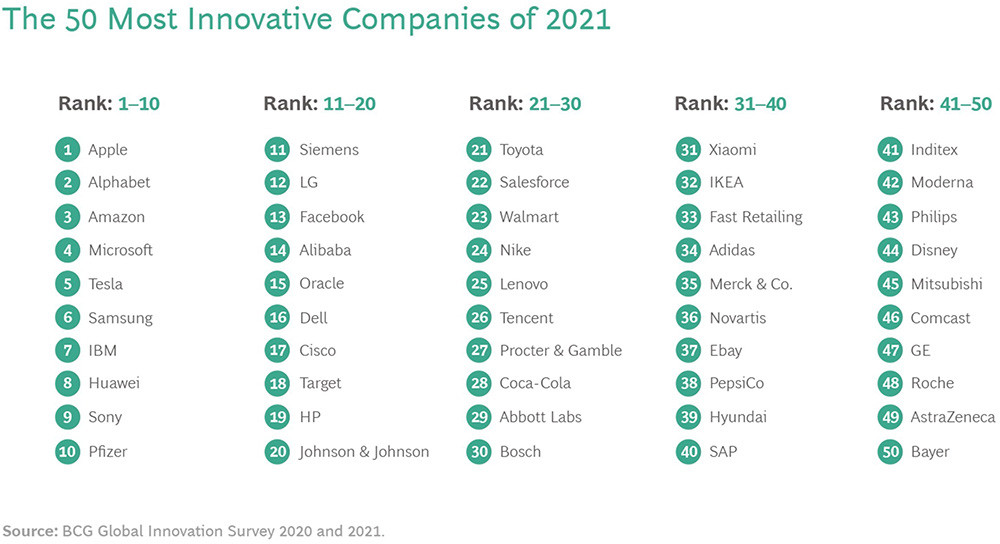According to the latest report from Boston Consulting Group (BCG), Most Innovative Companies 2021: Overcoming the Innovation Readiness Gap, the COVID-19 pandemic has demonstrated the importance of innovation excellence in turbulent times. Pharma companies performed strongly this year, joining technology and software companies that have dominated the rankings in recent years. The survey also identified strong regional variations in the innovation readiness of companies, with China and the US in the lead.
The report finds that only about 20% of companies globally have built high-performing innovation systems that can transform ambitious aspirations into real results. Moreover, some industries show big gaps in innovation readiness. Companies that are both committed (they back priorities with investment) and ready (they have the necessary platforms and practices in place) are up to four times as likely as those that aren’t to outperform their peers in terms of revenues from new products, services, and business models.
“Innovative companies have reaped the benefit of their earlier investment through this current crisis period, both for their shareholders and in terms of wider societal impact,” said Ramón Baeza, BCG managing director, and senior partner and a co-author of the report.

17 Companies Enter the Top 50
This year’s ranking of the 50 most innovative companies underscores the power of commitment and readiness. (See the list below.) In addition to 33 holdovers from last year, the 2021 list includes 12 companies that have returned to the top 50 after an absence of at least one year and 5 firms that are new to the list. While technology and software companies continue to dominate, this year’s ranking saw a breakout performance by pharma, with 9 companies ranked (three times the number in 2020), a third of them making their first appearance there.
Differences in readiness also show up in performance, as demonstrated by the shareholder returns that members of BCG’s previous 50 most innovative companies rankings have generated. “The pre-pandemic top 50 from 2020 have outperformed the MSCI World Index by a staggering 17 percentage points in the past year; and even if you remove the high-flying tech giants, top innovators still beat the index by 13 percentage points, demonstrating that investment in innovation delivers short-term as well as longer-term benefits, particularly in a time of crisis,” said Konstantinos Apostolatos, BCG managing director and senior partner and a co-author of the report.
Regional Divergences on Innovation
The US continues to lead with 27 of the top 50 companies (up by 2 from last year), driven by tech, software, and pharma companies. Owing to its relative lack of tech and software companies, Europe placed only 11 companies on this year’s list (down by 4 from the previous year), but it remained competitive in other sectors including automotive, medtech, pharma, industrials, and fashion. Although China earned only 4 spots among the top 50, more Chinese companies are likely to break into the ranking in coming years as they compete more visibly in global markets.
Diversity and Innovation
Companies in the top 50 tend to exhibit higher gender and ethnic diversity in their leadership: Microsoft, Alibaba, Cisco Systems, Philips, and Novartis, for example. “There’s this big chicken-and-egg question when it comes to diversity and innovation: what comes first?” said Johann Harnoss, associate director and report coauthor. “We tried to put this question to rest, using the unique data we have going back to 2005. We see clear evidence that its diversity that drives innovation, and not so much innovation attracting more diversity.”
Overcoming the Readiness Gap Is Essential
This year’s research reveals a worrisome readiness gap. On the positive side, 75% of companies identify innovation as a top-three priority (up 10% from 2020—the largest year-over-year increase in the 15-year history of the report), and 60% plan to increase their investment in innovation, with one-third of those planning to boost spending by more than 10%. But 80% of companies fall short of BCG’s innovation readiness benchmark across multiple dimensions of their innovation systems. The report suggests that attention to two areas can help bridge the gap: C-suite engagement and stronger bonds between product and sales teams.
BCG data shows that among companies that outperform their peers on innovation outcomes (as measured by the share of sales from new products and services), close to 90% demonstrate clear C-suite-level ownership, compared with only 20% of underperformers. Meanwhile, almost a third of companies in the 2021 survey cited less-than-optimal collaboration between their R&D and sales teams as their biggest barrier to higher innovation output.
“CEOs are ramping up their companies’ efforts and investment, recognizing that innovation’s power to boost resilience and drive advantage is more important than ever,” said Justin Manly, managing director and partner and report coauthor. “We see a risk, however, that their hopes will not be realized because their companies are not ready. The good news is that most can radically improve their readiness with a few targeted changes in strategy, operating model design, and organizational capabilities.”





